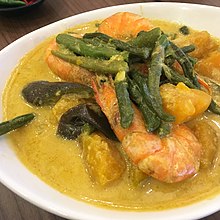
Cucurbita is a genus of herbaceous fruits in the gourd family, Cucurbitaceae, native to the Andes and Mesoamerica. Five edible species are grown and consumed for their flesh and seeds. They are variously known as squash, pumpkin, or gourd, depending on species, variety, and local parlance. Other kinds of gourd, also called bottle-gourds, are native to Africa and belong to the genus Lagenaria, which is in the same family and subfamily as Cucurbita, but in a different tribe. These other gourds are used as utensils or vessels, and their young fruits are eaten much like those of the Cucurbita species.

Cucurbita pepo is a cultivated plant of the genus Cucurbita. It yields varieties of winter squash and pumpkin, but the most widespread varieties belong to the subspecies Cucurbita pepo subsp. pepo, called summer squash.

Calabash, also known as bottle gourd, white-flowered gourd, long melon, birdhouse gourd, New Guinea bean, New Guinea butter bean, Tasmania bean, and opo squash, is a vine grown for its fruit. It can be either harvested young to be consumed as a vegetable, or harvested mature to be dried and used as a utensil, container, or a musical instrument. When it is fresh, the fruit has a light green smooth skin and white flesh.
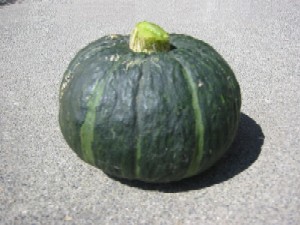
Kabocha is a type of winter squash, a Japanese variety of the species Cucurbita maxima. It is also called kabocha squash or Japanese pumpkin in North America. In Japan, "kabocha" may refer to either this squash, to the Western pumpkin, or indeed to other squashes. In Australia, "Japanese pumpkin" is a synonym of Kent pumpkin, a variety of winter squash.
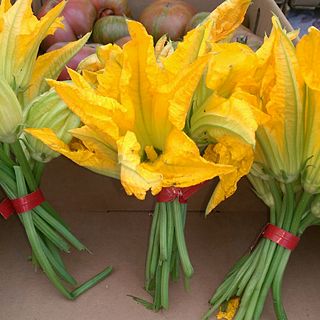
Squash blossoms are the edible flowers of Cucurbita species, particularly Cucurbita pepo, the species that produces zucchini (courgette), marrow, spaghetti squash, and many other types of squash.

A pumpkin seed, also known in North America as a pepita, is the edible seed of a pumpkin or certain other cultivars of squash. The seeds are typically flat and oval with one axis of symmetry, have a white outer husk, and are light green in color after the husk is removed. Some pumpkin cultivars are huskless, and are grown only for their edible seed. The seeds are nutrient- and calorie-rich, with an especially high content of fat, protein, dietary fiber, and numerous micronutrients. Pumpkin seed can refer either to the hulled kernel or unhulled whole seed, and most commonly refers to the roasted end product used as a snack.

Cucurbita ficifolia is a species of squash, grown for its edible seeds, fruit, and greens. It has common names including Asian pumpkin, black seed squash, chilacayote, cidra, fig-leaf gourd, and Malabar gourd. Compared to other domesticated species in its genus, investigators have noted that samples of C. ficifolia from throughout its range are relatively similar to one other in morphology and genetic composition. Variations do occur in fruit and seed color, some isozymes, and photoperiod sensitivity.

Butternut squash, known in Australia and New Zealand as butternut pumpkin or gramma, is a type of winter squash that grows on a vine. It has a sweet, nutty taste similar to that of a pumpkin. It has tan-yellow skin and orange fleshy pulp with a compartment of seeds in the blossom end. When ripening, the flesh turns increasingly deep orange due to its rich content of beta-carotene, a provitamin A compound.

Cucurbita moschata is a species originating in either Central America or northern South America. It includes cultivars known as squash or pumpkin. C. moschata cultivars are generally more tolerant of hot, humid weather than cultivars of C. maxima or C. pepo. They also generally display a greater resistance to disease and insects, especially to the squash vine borer. Commercially made pumpkin pie mix is most often made from varieties of C. moschata. The ancestral species of the genus Cucurbita were present in the Americas before the arrival of humans. No species within the genus is fully genetically isolated from all the other species. C. moschata can be hybridized with all other species. It has been suggested that this shows that the species of Cucurbita have diversified more recently than those of related genera such as Cucumis and Citrullus.
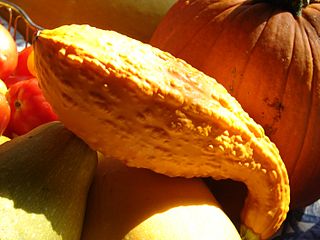
Crookneck squash, also known as yellow squash, is a cultivar of Cucurbita pepo, the species that also includes some pumpkins and most other summer squashes. The plants are bushy and do not spread like the plants of winter squash and pumpkin. Most often used as a summer squash, it is characterized by its yellow skin and sweet yellow flesh, as well as its distinctive curved stem-end or "crooked neck". It should not be confused with crookneck cultivars of Cucurbita moschata, such as the winter squash 'Golden Cushaw', or the vining summer squash 'Tromboncino'. Its name distinguishes it from another similar-looking variety of C. pepo, the straightneck squash, which is also usually yellow. There is one similar non-edible C. pepo variety: C. pepo var. ovifera.
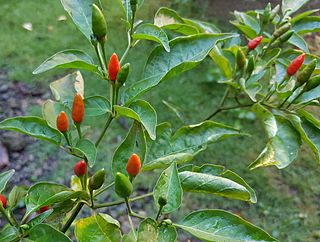
Siling labuyo is a small chili pepper cultivar that developed in the Philippines after the Columbian Exchange. It belongs to the species Capsicum frutescens and is characterized by triangular fruits that grow pointing upwards. The fruits and leaves are used in traditional Philippine cuisine. The fruit is pungent, ranking at 80,000 to 100,000 heat units in the Scoville Scale.

Delicata squash is a variety of winter squash with cylindrical fruits that are cream-coloured and striped in green or orange. As its name suggests, it has characteristically a delicate rind. It is also known as peanut squash, Bohemian squash, or sweet potato squash. It is a very sweet variety with a thin, edible skin and is typically cut into half rounds and roasted. It is a cultivar of the species Cucurbita pepo, which also includes the summer squash varieties pattypan squash, zucchini, and yellow crookneck squash, as well as winter squash varieties including acorn squash, spaghetti squash, and most pumpkins used as Jack-o-lanterns.

Winter squash is an annual fruit representing several squash species within the genus Cucurbita. Late-growing, less symmetrical, odd-shaped, rough or warty varieties, small to medium in size, but with long-keeping qualities and hard rinds, are usually called winter squash. They differ from summer squash in that they are harvested and eaten in the mature stage when their seeds within have matured fully and their skin has hardened into a tough rind. At this stage, most varieties of this vegetable can be stored for use during the winter. Winter squash is generally cooked before being eaten, and the skin or rind is not usually eaten as it is with summer squash.

Cucurbita maxima, one of at least five species of cultivated squash, is one of the most diverse domesticated species. This species originated in South America from the wild subspecies Cucurbita maxima subsp. andreana over 4,000 years ago. Cucurbita maxima, known for modern varieties as Hubbard, Delicious, Marblehead, Boston Marrow, and Turks Turban, originated in northern Argentina near the Andes or in certain Andean valleys. Secondary centers of diversity include India, Bangladesh, Myanmar, and the southern Appalachians.

A pumpkin is a cultivated winter squash in the genus Cucurbita. The term is most commonly applied to round, orange-colored squash varieties, though it does not possess a scientific definition and may be used in reference to many different squashes of varied appearance.
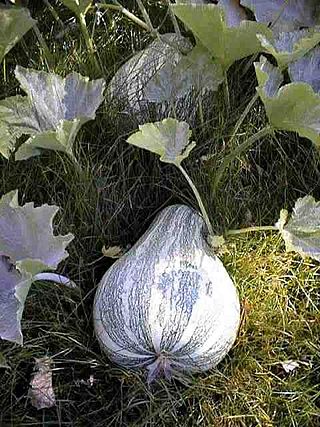
Cucurbita argyrosperma, also called the cushaw squash and silver-seed gourd, is a species of winter squash originally from the south of Mexico. This annual herbaceous plant is cultivated in the Americas for its nutritional value: its flowers, shoots, and fruits are all harvested, but it is cultivated most of all for its seeds, which are used for sauces. It was formerly known as Cucurbita mixta.

Kamokamo is a variety of Cucurbita pepo, grown as a summer or winter squash in New Zealand. Commonly used in Māori cuisine, the Kamokamo is a heavily ribbed oblate or prolate shaped stocky fruit with speckled green skin, ripening to an orange colour. It is thought to have been introduced to New Zealand during European settlement around the late 19th century and was readily adopted by Māori, displacing the calabash as a food source. Its name originates from the Māori language.

Tromboncino, also known as zucchetta, is a type of squash most often used as a summer squash.

Ube halaya or halayang ube is a Philippine dessert made from boiled and mashed purple yam. Ube halaya is the main base in ube/purple yam flavored-pastries and ube ice cream. It can also be incorporated in other desserts such as halo-halo. It is also commonly anglicized as ube jam, or called by its original native name, nilupak na ube.


